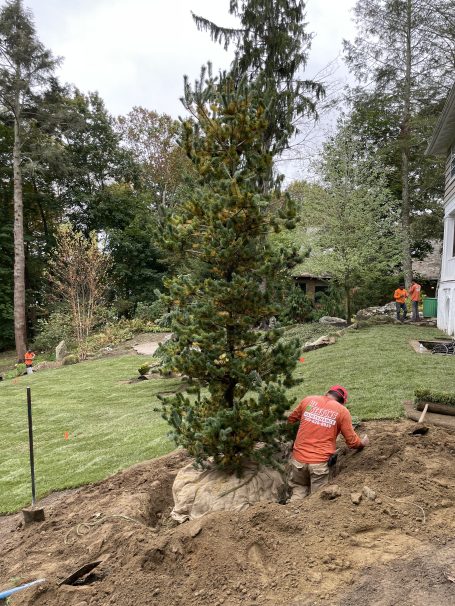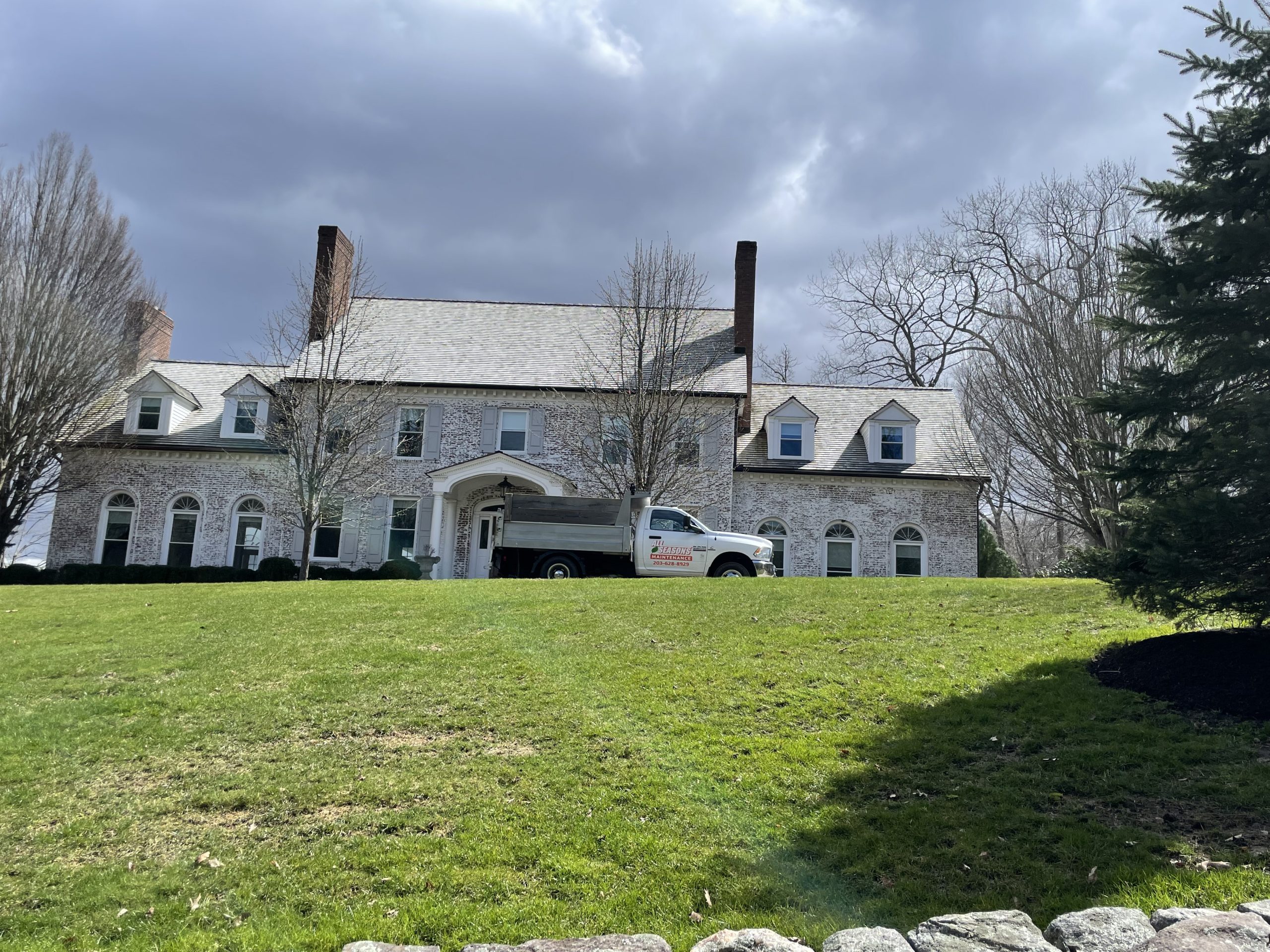Preparing Your Connecticut Landscape for Fall and Winter Success
Fall and winter in Connecticut bring beautiful seasonal changes, but they also demand specific preparation to protect your landscape investment. The work you do now determines whether your plants emerge healthy in spring or require expensive repairs and replacements.
Connecticut’s freeze-thaw cycles, heavy snow loads and fluctuating temperatures create unique challenges that can damage unprepared landscapes. But with proper preparation, your property can weather the cold months beautifully and emerge stronger in spring. This comprehensive checklist covers everything you need to prepare your entire landscape – from lawn to trees, shrubs, garden beds and hardscaping – for the cold months ahead.
Fall Lawn Care Essentials
Your lawn requires specific attention in fall to prepare for winter dormancy and next spring’s growth.
Aeration and Overseeding: Fall is ideal for core aeration in Connecticut because soil is still warm enough for grass roots to recover while cooler air temperatures reduce stress. Aeration relieves soil compaction that builds up over the growing season, allowing water, oxygen and nutrients to reach grass roots where they’re needed. Pair it with overseeding to fill thin areas and bare spots – seeds fall into aeration holes where they make excellent soil contact, dramatically improving germination rates. This combination creates a thicker, healthier lawn that naturally crowds out weeds and handles stress better. Professional lawn care services use commercial-grade equipment that penetrates deeper and covers ground more efficiently than rental machines.
Final Fertilization: Your lawn’s winterizer application in late October or early November is critical for spring success. Apply this treatment after your grass has stopped actively growing but before the ground freezes. These fertilizers are higher in potassium, which strengthens grass cell walls and improves cold tolerance. They also provide nitrogen that grass roots store over winter, fueling that impressive early spring green-up before you even think about your first spring feeding. Timing matters significantly, so professional fertilization services ensure proper timing and application rates for optimal results.
Leaf Management and Final Mowing: Heavy leaf layers smother grass and create perfect conditions for snow mold and other diseases. Manage leaves regularly throughout fall rather than waiting for all trees to drop – weekly removal during peak season prevents matted layers that damage grass. You can mulch thin layers with a mulching mower, but thick accumulations need complete removal. Keep mowing as long as your grass is growing, which in Connecticut often extends into mid-November. Gradually lower your mowing height as fall progresses, ending at about 2.5 to 3 inches for your final cut. This prevents grass from matting under snow while avoiding scalping that exposes grass crowns to winter damage.
Preparing Trees and Shrubs for Winter
Trees and shrubs represent significant investments that need proper fall preparation.
Pruning and Protection: Remove dead, damaged or diseased branches before winter storms arrive – these compromised branches are more likely to break under snow and ice loads, potentially causing property damage. However, avoid heavy pruning of healthy growth in fall and never prune spring-blooming shrubs like lilacs or forsythia – you’ll be cutting off next spring’s flower buds. Apply anti-desiccant sprays to broadleaf evergreens like rhododendrons in late fall to reduce winter moisture loss and prevent browning. Young or tender shrubs benefit from burlap wrapping after several hard frosts, which shields them from harsh winds without blocking air circulation. For proper pruning guidance specific to Connecticut plants, the UConn Home & Garden Education Center offers excellent resources.
Watering and Mulching: One of the most overlooked fall tasks is deep watering. Evergreens and newly planted trees or shrubs need thorough watering before the ground freezes, typically in late November. Winter winds continue pulling moisture from evergreen foliage, but frozen ground prevents roots from replacing that water. Plants entering winter well-hydrated handle this stress much better. Add a fresh layer of 2 to 3 inches of mulch around trees and shrubs after the ground begins to cool. This mulch provides insulation that moderates soil temperature fluctuations through winter. Keep mulch several inches away from trunks to prevent rot and rodent damage – never create “volcano” mulch piles against trunks.

Garden Bed and Perennial Care
Cutting Back and Division: Cut back disease-prone perennials like peonies, bee balm and phlox to prevent disease spores from overwintering. However, leave standing plants with attractive seed heads like coneflowers, black-eyed Susans and ornamental grasses – these provide winter interest and food for birds while helping trap insulating snow. Fall is actually ideal for dividing overgrown perennials in Connecticut. The soil is still warm enough for root establishment while cooler air reduces stress on plants. Focus on spring-blooming perennials like daylilies, hostas and Siberian iris. Complete divisions by mid-October to give plants time to establish before hard freezes arrive.
Mulching and Bulb Planting: Wait until after your first hard frost to mulch perennial beds – mulching too early can encourage rodents to nest and might delay dormancy. Once the ground begins to freeze, apply 2 to 3 inches of shredded leaves, straw or other loose mulch over beds. This mulch moderates the freeze-thaw cycles that heave plants out of the ground and damage roots. Fall is your only opportunity to plant spring-flowering bulbs like tulips, daffodils, crocuses and hyacinth. Connecticut’s ideal bulb-planting window runs from September through November, with October being optimal. Plant bulbs at a depth of two to three times their height, pointed end up. Group bulbs in clusters for more natural-looking spring displays and protect newly planted bulbs from squirrels with chicken wire or by mixing in daffodils, which animals avoid.
Hardscaping and Outdoor Structures
Hardscaping Inspection: Inspect patios, walkways and walls for cracks. Small cracks become major problems when water freezes and expands. Repair damage now and consider sealing pavers for moisture protection. Professional hardscaping services ensure your investment stays protected through harsh winters.
Irrigation and Gutter Systems: Failing to properly winterize your irrigation system can result in thousands of dollars in repairs. Water left in lines expands when it freezes, cracking pipes and damaging sprinkler heads and valves. Professional winterization involves blowing compressed air through the system to remove all water. Schedule this before the first hard freeze, typically by late October or early November. Clean gutters thoroughly in late fall after most leaves have dropped. Clogged gutters cause water to overflow, potentially damaging your foundation, creating ice dams on your roof and flooding landscape beds. Check that downspouts direct water at least 4 to 6 feet away from your foundation.
Storage and Cleanup: Store outdoor furniture and cushions properly. Drain and store hoses to prevent freeze damage. Remove fragile decorations before winter storms arrive.
Preparing for Winter Weather
Tree Assessment and Protection: Identify dead limbs or weak branches before winter storms. Heavy snow and ice can bring down compromised branches. Check and adjust stakes on young trees and consider tree wrap for thin-barked species. Mark landscape edges, beds and irrigation heads with stakes before snowfall to prevent damage from snow removal equipment. Snow removal services understand how to clear your property while protecting your landscape.
Tool Maintenance: Service lawn equipment before storing – change oil, clean thoroughly and add fuel stabilizer. Prepare snow removal tools and ensure snow blowers run properly before you need them.
Connecticut-Specific Considerations
Salt Damage Prevention: Road salt devastates landscape plants. Create burlap barriers between roadways and sensitive plants like boxwoods and evergreens. Use environmentally-friendly alternatives like calcium magnesium acetate for your property. The CT DEEP website offers guidance on environmentally-responsible winter practices.
Winter Pest Protection: Voles and mice girdle tree bark under snow. Pull mulch back from trunks and wrap lower trunks with hardware cloth. Protect vulnerable shrubs from deer browsing with fencing or repellent sprays before snow arrives. Use chicken wire cages for plants susceptible to rabbit damage.
Microclimate Awareness: Understand your property’s microclimates. South-facing areas stay warmer while north-facing spots need hardier plants or extra protection. Connecticut spans zones 5b to 7a, so know your specific zone for appropriate plant selection.
Protect Your Landscape Investment
Preparing your Connecticut landscape for fall and winter protects your property’s beauty and value. Every task on this checklist prevents winter damage, supports plant health and sets the stage for vigorous spring growth.
The comprehensive nature of proper preparation can feel overwhelming. Many tasks require specific knowledge about Connecticut’s climate, proper timing and specialized equipment. Professional landscaping services bring expertise and efficiency to handle preparation comprehensively.
All Seasons Maintenance specializes in complete fall and winter landscape preparation for Connecticut homeowners. From expert lawn care services and aeration to comprehensive landscape maintenance, tree care and winterization, our experienced team handles everything your property needs. Our comprehensive landscaping services cover every aspect of preparing your property for the cold months ahead.
Don’t let another season pass watching your landscape suffer preventable winter damage. The time you invest now – or the professional services you hire – pay dividends when your landscape emerges healthy and ready to thrive.
Ready to prepare your landscape for fall and winter?
Call us today at (203) 885-0001 or request a free quote. Let us handle your fall and winter prep so your landscape weathers the cold months beautifully.

